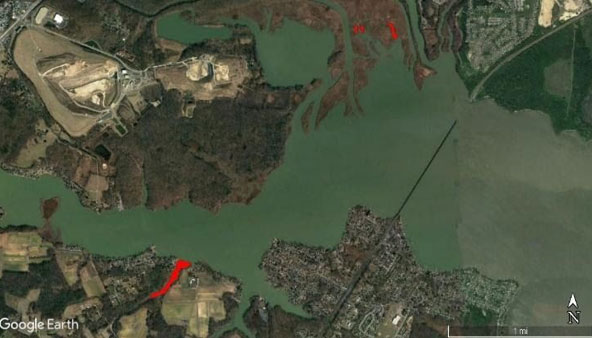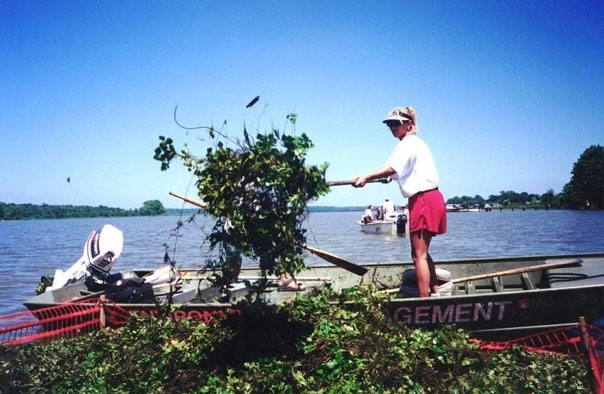Water Chestnut
Water chestnut
(Trapa natans) is an aquatic plant native to Asia. Introduced to North America near Concord, Massachusetts in 1859, water chestnut became established in locations throughout the northeast and by the early 20th century was moving southward. It can be found from Maryland north to Maine and in some parts of Canada. Check out a detailed view of the water chestnut plant below. This aggressive species is a prolific reproducer. One acre of water chestnut can produce enough seeds to cover 100 acres the following year. With four hard half-inch long spines that are sharp enough to penetrate shoe soles and large enough to keep people off beaches, water chestnut seeds are major hazards to water contact recreation.
ALERT!! A new species
(Trapa bispinosa), which is related to water chestnut, has recently been found in Maryland.
Additionally, water chestnuts can reduce native bay grasses from areas in which dense beds grow, create breeding grounds for mosquitoes, and provide poor habitat for native fish and birds. To help control its distribution, the sale of all species of water chestnut are banned from most of the United States, including Maryland.
Water Chestnut History in Maryland
Water chestnut first appeared in Maryland in the Potomac River near Washington, D.C. as a two-acre patch in 1923. The plant spread rapidly, covering 40 river miles within a few years. By 1933, 10,000 acres of dense beds extended from Washington, D.C. to just south of Quantico, VA. This resulted in the loss of bay grasses, and the U.S. Army Corps of Engineers responded by conducting a massive removal effort from 1939 to 1945, with follow-up removal by hand until at least 1965. The cost was estimated at $4.1 million (converted from 1950 to 2020 dollars).
Water chestnut was recorded in the Bird River in Baltimore County for the first time in 1955. The Maryland Departments of Game and Inland Fish and Tidewater Fisheries used mechanical removal and an herbicide (2,4-D) to control the population. However, in 1964 it reappeared in the Bird River and an additional 100 acres were discovered in the Sassafras River in Kent County. A combination of removal techniques were used once again in 1965, when 200 acres were removed from the Sassafras.
The harvesting efforts were believed to have been successful, and no plants had been reported until the summer of 1997 when a landowner on the Bird River noticed an unusual plant growing in the river. This led to the discovery of a small population of water chestnut in a cove just upriver from Railroad Creek. From the summer of 1997 to the summer of 1998, these plants expanded from 3 acres to approximately 30 acres, and reports were also received of water chestnut growing in Lloyds Creek of the Sassafras River. Both populations were in the same locations from which water chestnut had been harvested in the 1960's, suggesting that this was a resurgence of the same population of plants. Mechanical harvesting boats, usually used to clear hydrilla from marinas, were contracted to remove the water chestnut beds. A massive mechanical and volunteer harvesting effort began on both rivers in 1999, resulting in the removal of approximately 400,000 pounds of plants from the two rivers.

Figure 5. Bird River water chestnut historical locations (shown in red)

Figure 6. Sassafras River water chestnut historical locations (shown in red)
Less than 1,000 pounds of plants were discovered and removed from rivers in 2000, indicating that mechanical and hand removal efforts were successfully reducing the population. A combination approach was used, with mechanical harvesting by boat followed by hand removal by volunteers for the next 3 years. By 2003 there were not enough plants at any of these locations to justify using a mechanical harvester- a significant milestone for the overall eradication effort. Since then, Resource Assessment Service staff together with volunteers from within DNR and local watershed organizations assist with an annual clean-up done by hand using small boats.
Physical removal of the plants themselves has proven to be the biggest challenge to controlling water chestnut. Water chestnut is a large plant with an extensive root system and harvest boats fill quickly. One innovation that DNR has developed is the floating composter. A simple frame of pressure treated lumber is constructed and surrounded by storm fencing to keep the plant material from floating away. Thousands of pounds of plants can be disposed of in a single composter, where the plants rapidly disintegrate, disappearing completely in just a few weeks. DNR has utilized these composters in remote areas where access is limited.

Figure 7. A DNR biologist loads water chestnut into the floating composter
Partnerships
As there is no dedicated funding for water chestnut control, establishing partnerships is crucial to controlling the population. In 2007, the Sassafras River Association (SRA) began working with DNR as a partner to control water chestnut. Since then, the SRA has become ShoreRivers Inc., and the Sassafras Riverkeeper has played a leading role in the water chestnut eradication effort. The Riverkeeper mobilizes their volunteer base to provide an annual workforce that conducts several removal days each summer. DNR has also utilized the Maryland Conservation Corps and the Chesapeake Conservation Corps members as well as other DNR field and office staff to assist with the collections annually.
Distribution
While the Maryland water chestnut populations have been largely limited to the Bird and Sassafras Rivers, there have been a few ponds on private and public property that have also required water chestnut control. In 2007, a private landowner off of Woodland Creek in the Sassafras watershed contacted the department to request a survey of a sediment pond on the property. Approximately two acres of the pond were covered with water chestnut. After an unsuccessful hand removal effort, a drawdown was done over the winter in an attempt to reduce the population, and the next year it was treated in July with the herbicide Clearcast. This was effective, and little water chestnut was left in the pond in the summer of 2009. An outreach effort was conducted through the Sassafras River Association to find any private landowners that may have water chestnut infestations on their property, but no other infestations were reported. Smaller infestations have been found in two ponds in Harford County, but those infestations were controlled by the property owners. In any given year, the locations of water chestnut infestations varies widely, as does the severity of the infestation. The seeds can remain viable for up to twelve years, so even if removal is successful one year, scattered plants appear year after year.
|
 Figure 8. Sassafras Riverkeeper Zack Kelleher gathering water chestnut in Ponds Bar on the Sassafras Figure 8. Sassafras Riverkeeper Zack Kelleher gathering water chestnut in Ponds Bar on the Sassafras |
On the Bird River, the plants are found in the same general areas where water chestnut was first discovered. DNR biologists use kayaks to conduct a broad search between Mariner Point and Days Cove on the north side of the river. There are several miles of canoe and kayak trails that have small populations of water chestnut. On the south side of the river, the small unnamed cove east of Railroad Creek has a persistent population of water chestnut. It was the site of the largest original infestation that reached thirty acres in 1999. DNR biologists collect at that site each year, but the seed bank has persisted since that time.
Maryland has been on the lookout for a new Trapa species, Trapa bispinosa, which has been spreading in the Virginia side of the Potomac River. It has made its way inland and has been observed in numerous ponds, lakes and impoundments in that state. lDNR Fishing and Boating Service field crews have been keeping a watchful eye as they conduct Potomac field operations, but so far there have been no infestations discovered on Maryland’s side of the river.
See Bay Journal article: Invasive water plant poised to overwhelm Potomac watershed
Current Managementof Trapa species
In 2024, less than 100 pounds of water chestnut (Trapa natans) were collected in the Sassafras River watershed. Very few plants were observed in Dyer, Island Creek, Money Creek and Turners Creeks, which in years past have typically had abundant trapa. Lloyds Creek, which has had very dense infestations in its headwaters over the last few years, had just a dozen plants collected. A private retention pond that was filled with trapa in 2023 did not have any plants this year. The riverkeeper has been scouting creeks using drones and following up with ground truthing to ensure the trapa is being controlled. Across the Bay, less than 100 pounds of water chestnut were removed from the Bird River, mostly from the creeks adjacent to Railroad Creek. DNR biologists visited the area in July but found very few plants in locations where water chestnut persisted. DNR will continue to monitor all of the previous locations to ensure the dormant seeds do not re-emerge.
DNR has been working with the homeowner’s association of the Todd Lakes community in Harford County to manage a large infestation of Trapa natans in two of their community lakes. The association contacted DNR for advice on a control plan beginning with a large-scale manual removal followed up with a chemical treatment. In Late June, DNR staff, with the help of Maryland Conservation Corps crew members removed close to 2000 lbs. of water chestnut from one of the lakes. The community hired a contractor to conduct an herbicide treatment in early July. The treatment was not successful, so the community has drawn down the lake in an effort to destroy the seed bank. They are currently seeking a new herbicide contractor for a chemical treatment next year.
A related species of water chestnut, Trapa bispinosa, continues to spread in Maryland. The largest infestation was located in Beaverdam Pond at the Beltsville Agricultural Research Center. After the manual effort from 2023 was unsuccessful, DNR worked with the US Fish and Wildlife Service to install a drainpipe through the beaver dam that created the pond to lower the water level. The pipe was not effective at draining the pond, so USFWS harvested all of the beavers present and breached the dam. The resulting draw-down effectively wiped out the population of Trapa bispinosa throughout the summer of 2024. In 2025, DNR hopes to allow the seeds to germinate in spring, then conduct another drawdown before seed production in July.
There are currently two other populations of Trapa bispinosa that are being monitored in MD. Greenbelt Lake has had a population of bispinosa for the last two years. A manual harvest was conducted in Greenbelt Lake by DNR, Prince George’s County Staff and volunteers in July of 2024. DNR received a report of a new infestation of Trapa bispinosa on a private farm in Poolesville in late summer and is currently working with the farmer to manage the population. The owner will conduct a manual removal of the seed bank over the winter, followed up by herbicide treatments in spring of 2025.

Figure 9. Water chestnut harvest by year
The observations from 2024 indicate that although removal efforts can be successful at preventing the expansion of water chestnut, populations are dynamic and require thorough annual follow-up visits. A small patch that goes unnoticed one year can easily fill a small cove and spread enough seed to sustain a population for years. Vigilant monitoring and information from residents, volunteers and other agencies is critical to staying ahead of this invasive plant. DNR and our partners will continue annual surveys to ensure the Bird and Sassafras remain free of this invasive species and monitor the spread of Trapa bispinosa as well. If you have observed water chestnut in these or any other rivers in Maryland, please contact Mark Lewandowski at 410-260-8634 or email [email protected].